Related Research Articles

John Bardeen was an American physicist and electrical engineer. He is the only person to be awarded the Nobel Prize in Physics twice: first in 1956 with William Shockley and Walter Brattain for the invention of the transistor; and again in 1972 with Leon N. Cooper and John Robert Schrieffer for a fundamental theory of conventional superconductivity known as the BCS theory.
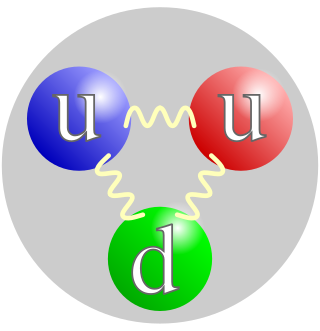
A quark is a type of elementary particle and a fundamental constituent of matter. Quarks combine to form composite particles called hadrons, the most stable of which are protons and neutrons, the components of atomic nuclei. All commonly observable matter is composed of up quarks, down quarks and electrons. Owing to a phenomenon known as color confinement, quarks are never found in isolation; they can be found only within hadrons, which include baryons and mesons, or in quark–gluon plasmas. For this reason, much of what is known about quarks has been drawn from observations of hadrons.

Richard Phillips Feynman was an American theoretical physicist. He is best known for his work in the path integral formulation of quantum mechanics, the theory of quantum electrodynamics, the physics of the superfluidity of supercooled liquid helium, and in particle physics, for which he proposed the parton model. For his contributions to the development of quantum electrodynamics, Feynman received the Nobel Prize in Physics in 1965 jointly with Julian Schwinger and Shin'ichirō Tomonaga.
A timeline of atomic and subatomic physics, including particle physics.

Steven Weinberg was an American theoretical physicist and Nobel laureate in physics for his contributions with Abdus Salam and Sheldon Glashow to the unification of the weak force and electromagnetic interaction between elementary particles.
Supersymmetry is a theoretical framework in physics that suggests the existence of a symmetry between particles with integer spin (bosons) and particles with half-integer spin (fermions). It proposes that for every known particle, there exists a partner particle with different spin properties. There have been multiple experiments on supersymmetry that have failed to provide evidence that it exists in nature. If evidence is found, supersymmetry could help explain certain phenomena, such as the nature of dark matter and the hierarchy problem in particle physics.
The up quark or u quark is the lightest of all quarks, a type of elementary particle, and a significant constituent of matter. It, along with the down quark, forms the neutrons and protons of atomic nuclei. It is part of the first generation of matter, has an electric charge of +2/3 e and a bare mass of 2.2+0.5
−0.4 MeV/c2. Like all quarks, the up quark is an elementary fermion with spin 1/2, and experiences all four fundamental interactions: gravitation, electromagnetism, weak interactions, and strong interactions. The antiparticle of the up quark is the up antiquark, which differs from it only in that some of its properties, such as charge have equal magnitude but opposite sign.
The bottom quark, beauty quark, or b quark, is an elementary particle of the third generation. It is a heavy quark with a charge of −1/3 e.
The spin–statistics theorem proves that the observed relationship between the intrinsic spin of a particle and the quantum particle statistics of collections of such particles is a consequence of the mathematics of quantum mechanics. In units of the reduced Planck constant ħ, all particles that move in 3 dimensions have either integer spin and obey Bose–Einstein statistics or half-integer spin and obey Fermi–Dirac statistics.
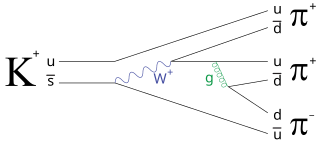
In particle physics, a kaon, also called a K meson and denoted
K
, is any of a group of four mesons distinguished by a quantum number called strangeness. In the quark model they are understood to be bound states of a strange quark and an up or down antiquark.

In physics, an effective field theory is a type of approximation, or effective theory, for an underlying physical theory, such as a quantum field theory or a statistical mechanics model. An effective field theory includes the appropriate degrees of freedom to describe physical phenomena occurring at a chosen length scale or energy scale, while ignoring substructure and degrees of freedom at shorter distances. Intuitively, one averages over the behavior of the underlying theory at shorter length scales to derive what is hoped to be a simplified model at longer length scales. Effective field theories typically work best when there is a large separation between length scale of interest and the length scale of the underlying dynamics. Effective field theories have found use in particle physics, statistical mechanics, condensed matter physics, general relativity, and hydrodynamics. They simplify calculations, and allow treatment of dissipation and radiation effects.

Jack Steinberger was a German-born American physicist noted for his work with neutrinos, the subatomic particles considered to be elementary constituents of matter. He was a recipient of the 1988 Nobel Prize in Physics, along with Leon M. Lederman and Melvin Schwartz, for the discovery of the muon neutrino. Through his career as an experimental particle physicist, he held positions at the University of California, Berkeley, Columbia University (1950–68), and the CERN (1968–86). He was also a recipient of the United States National Medal of Science in 1988, and the Matteucci Medal from the Italian Academy of Sciences in 1990.
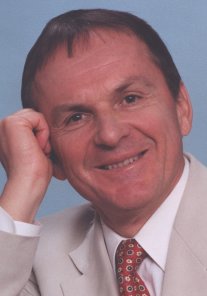
Hagen Kleinert is professor of theoretical physics at the Free University of Berlin, Germany , Honorary Doctor at the West University of Timișoara, and at the Kyrgyz-Russian Slavic University in Bishkek. He is also Honorary Member of the Russian Academy of Creative Endeavors. For his contributions to particle and solid-state physics he was awarded the Max Born Prize 2008 with Medal. His contribution to the memorial volume celebrating the 100th birthday of Lev Davidovich Landau earned him the Majorana Prize 2008 with Medal. He is married to Dr. Annemarie Kleinert since 1974 with whom he has a son Michael Kleinert.

In particle physics, the history of quantum field theory starts with its creation by Paul Dirac, when he attempted to quantize the electromagnetic field in the late 1920s. Major advances in the theory were made in the 1940s and 1950s, leading to the introduction of renormalized quantum electrodynamics (QED). The field theory behind QED was so accurate and successful in predictions that efforts were made to apply the same basic concepts for the other forces of nature. Beginning in 1954, the parallel was found by way of gauge theory, leading by the late 1970s, to quantum field models of strong nuclear force and weak nuclear force, united in the modern Standard Model of particle physics.

John (Jean) Iliopoulos is a Greek physicist. He is the first person to present the Standard Model of particle physics in a single report. He is best known for his prediction of the charm quark with Sheldon Glashow and Luciano Maiani. Iliopoulos is also known for demonstrating the cancellation of anomalies in the Standard model. He is further known for the Fayet-Iliopoulos D-term formula, which was introduced in 1974. He is currently an honorary member of Laboratory of theoretical physics of École Normale Supérieure, Paris.
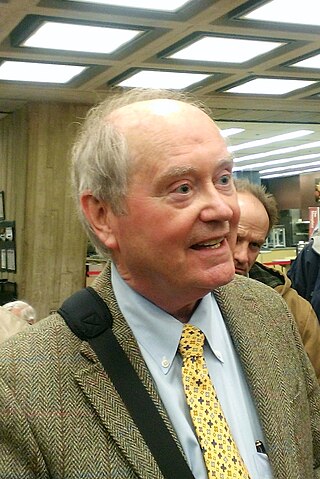
Chris Quigg is an American theoretical physicist at the Fermi National Accelerator Laboratory (Fermilab). He graduated from Yale University in 1966 and received his Ph.D. in 1970 under the tutelage of J. D. Jackson at the University of California, Berkeley. He has been an associate professor at the Institute for Theoretical Physics, State University of New York, Stony Brook, and was head of the Theoretical Physics Department at Fermilab from 1977 to 1987.
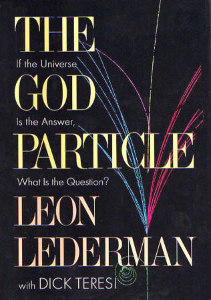
The God Particle: If the Universe Is the Answer, What Is the Question? is a 1993 popular science book by Nobel Prize-winning physicist Leon M. Lederman and science writer Dick Teresi.
Lawrence Christian Biedenharn, Jr. was an American theoretical nuclear physicist and mathematical physicist, a leading expert on applications of Lie group theory to physics.
Lillian Hartman Hoddeson is an American historian of science, specializing in the history of physics and technology during the 2nd half of the 20th century.
Max Dresden was a Dutch-American theoretical physicist and historian of physics. He is known for his research in "statistical mechanics, superconductivity, quantum field theory, and elementary particle physics."
References
- ↑ In Memoriam Laurie Brown, Department of Physics and Astronomy, Northwestern University
- ↑ "Laurie Mark Brown". U.S., World War II Draft Cards Young Men, 1940–1947. Retrieved 8 May 2024.
- ↑ Feynman, R. P.; Brown, L. M. (15 January 1952). "Radiative corrections to Compton Scattering" (PDF). Phys. Rev. 85 (2): 231–244. Bibcode:1952PhRv...85..231B. doi:10.1103/PhysRev.85.231.
- ↑ Feynman, R. P. (2005). Brown, Laurie M. (ed.). Feynman's Thesis: A New Approach to Quantum Theory. World Scientific. Bibcode:2005ftna.book.....B. ISBN 978-981-256-366-8.; pbk . World Scientific. 2005. ISBN 978-981-256-380-4.
- ↑ Feynman, R. P. (2000). Brown, Laurie M. (ed.). Selected Papers of Richard Feynman: With Commentary . World Scientific. ISBN 978-981-02-4130-8.; Feynman, Richard Phillips (2000). pbk . World Scientific. ISBN 978-981-02-4131-5.
- ↑ Dilworth, C. (27 July 1990). "Review of Pions and Quarks by L. M. Brown, M. Dresden, & L. Hoddeson". Science. 249 (4967): 426–427. Bibcode:1990Sci...249..426B. doi:10.1126/science.249.4967.426. PMID 17755946.
- ↑ Mackay, A. (1996). "Review of Twentieth Century Physics ed. by L. M. Brown, A. Pais, & B. Pippard" (PDF). Science Progress. 79 (2): 159–162.